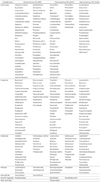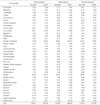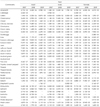Abstract
The characteristics of pesticide residues were examined in 18,069 samples from 91 vegetable commodities collected in Seoul from 2007 to 2009, and the vegetable dietary intakes of Seoulites were estimated using the Korea National Health and Nutrition examination survey data from 2008. The hazard index was calculated using vegetable pesticide residues and dietary vegetable intake by Seoulites. Detection rates for pesticide residues in vegetables were 11.2 % in 2007, 8.6 % in 2008, and 12.0 % in 2009. Excess rate of Maximum Residue Limits tended to decline from 4.6 % in 2007, to 2.8 % in 2008, and 2.1 % in 2009. Daily vegetable intake for Seoulites was 288.12 ± 214.8 g, and vegetable intake by males was more than that of females (p < 0.001). The hazard index was the highest at 2.76 × 10-2 in 2007, and the lowest at 1.69 × 10-2 in 2009. The risks caused by multiple pesticides in vegetables were very low and vegetable intake was safe considering the hazard index values.
Figures and Tables
References
1. Ministry for Food, Agriculture, Forestry and Fisheries. White paper on the agri-food safety. 2009. 9–10.
2. Lee BH, Kim SY, Cho CH, Chung DK, Chun OK, Kim DO. Estimation of daily per capita intake of total phenolics, total flavonoids, and antioxidant capacities from fruit and vegetable juices in the Korean diet based on the Korea National Health and Nutrition Examination Survey 2008. Korean J Food Sci Technol. 2011. 43(4):475–482.

3. Ministry of Health and Welfare, Korea Health Industry Development Institute. The Third Korea National Health & Nutrition Examination Survey, 2005-Nutrition Survey (II). 2006.
4. Kim HY, Yoon SH, Park HJ, Lee JH, Gwak IS, Moon HS, Song MH, Jang YM, Lee MS, Park JS, Lee KH. Monitoring of residual pesticides in commercial agricultural products in Korea. Korean J Food Sci Technol. 2007. 39(3):237–245.
5. Lee JK, Woo HD. Current status for management of pesticide maximum residue limits in foods. Food Sci Ind. 2010. 43(2):2–23.
6. Korea Food and Drug Administration. Korea food code. 2011.
7. Kim OH, Park SK, Ha KT, Choi YH, Seung HJ, Kim SJ, Lee KA, Jang JI, Jo HB, Choi BH, Kim MY. Monitoring and risk assessment of pesticide residues in vegetables cultivated from different areas of Korea in 2009. Rep Seoul Metrop Gov Res Inst Public Health Environ. 2009. 45:44–65.
8. Lee SM, Papathakis ML, Feng HM, Hunter GF, Carr JE. Multipesticide residue method for fruits and vegetables: California Department of Food and Agriculture. Fresenius J Anal Chem. 1991. 339(6):376–383.

9. Korea Centers for Disease Control and Prevention. The Fourth Korea National Health and Nutrition Examination Survey (KNHANES VI-2), 2008. 2008.
10. Korea Research Institute of Standards and Science. Report of 5th size Korea. 2004.
11. Pesticide residue database. Korea Food and Drug Administration. Accessed 2010 Mar 7. Available from: http://www.foodnara.go.kr/.
12. Yoon SH. Rapid analysis of multi-pesticides residues by extracted ion profiling and risk assessment of residual pesticides agricultural products. 2009. Seoul: Seoul National University;[Ph. D. thesis].
13. Ministry of Health and Welfare. The In-depth analysis of Korea Health Industry Development Institute. The Third Korea National Health and Nutrition Examination Survey (KNHANES III), 2005. 2006.
14. Lee SR, Lee H, Huh K, Lee MG. Optimization of average food consumption data for Koreans in 1990s. J Food Hyg Saf. 2000. 15(2):68–78.
15. Jang M, Moon H, Kim T, Yuk D, Kim J, Park S. Dietary risk assessment for pesticide residues of vegetables in Seoul, Korea. Korean J Nutr. 2010. 43(4):404–412.

16. Chun OK, Lee YW. A study on the risk of pesticide exposure by food intake. J Food Hyg Saf. 1999. 14(2):201–215.
17. Lee SR, Lee MG, Kim NH. Computation of theoretical maximum daily intake and safety index of pesticides by Korean population. Korean J Food Sci Technol. 1995. 27(4):618–624.
18. Lee SR, Lee MG. Computation of theoretical maximum daily intake of pesticides by Korean population. Food Sci Biotechnol. 2001. 10(2):115–122.
19. Lee SR, Lee MG. Present status and remedial actions with regard to legal limits of pesticide residues in Korea. Korean J Environ Agric. 2001. 20(1):34–43.
20. Lee SR. Pesticide problems and regulatory aspects in USA. Korean J Environ Agric. 1991. 10(2):178–196.
21. Guidance on cumulative risk assessment of pesticide chemicals that have a common mechanism of toxicity. 2002. Washington, D.C.: Office of Pesticide Programs, U.S. Environmental Protection Agency.
22. Supplementary guidance for conducting health risk assessment of chemical mixtures. 2000. Washington, D.C.: Risk Assessment Forum, U.S. Environmental Protection Agency.
23. Mumtaz MM. Risk assessment of chemical mixtures from a public health perspective. Toxicol Lett. 1995. 82-83:527–532.

24. Bosgra S, van der Voet H, Boon PE, Slob W. An integrated probabilistic framework for cumulative risk assessment of common mechanism chemicals in food: an example with organophosphorus pesticides. Regul Toxicol Pharmacol. 2009. 54(2):124–133.

25. Kim TR, Yuk DH, Jang MR, Hong CK, Hawng KH, Jo SA, Lee ES, Choi CM, Kim EH, Han SH, Choi EJ, Kim JH, Park SG. Characteristics of pesticide residues in agricultural products collected from the southern area of Seoul in 2009. Rep Seoul Metrop Gov Res Inst Public Health Environ. 2009. 45:21–33.




 PDF
PDF ePub
ePub Citation
Citation Print
Print











 XML Download
XML Download